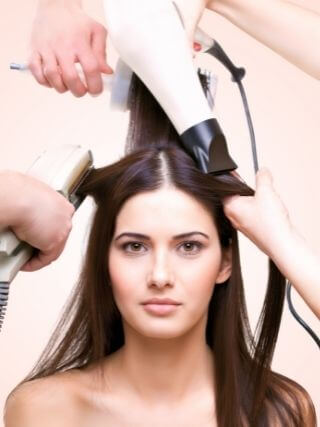Trichorrhexis nodosa is a common hair issue in which the hair shaft gets weaker in between causing the hair and causes hair breakage in the middle. Excessive chemical usage, over-brushing, ironing, perming, or blow-drying can all contribute to the condition.
Table of Contents
What Causes Hair Breakage in the Middle?
Trichorrhexis nodosa, a hair shaft disease, is the most common cause of mid-shaft hair breakage. Due to the loss of hair’s cuticle, those who suffer from this condition typically have thin, brittle hair. When the cuticle falls off, the exposed fibers split and begin to tear. Cuticle-less hair is more prone to breaking and breakage can cause widespread or patchy baldness depending on how it is treated. Despite the fact that Trichorrhexis nodosa can emerge as early as birth, it is most commonly found later in life due to hairstyle practices. In addition to frequent chemical relaxers and overuse of brushes and heat tools, scratching your hair can also lead to breakage.
How to Identify if your breaking hair is due to Trichorrhexis nodosa
Trichorrhexis nodosa patients typically have thinning, uneven hair on the top and back of the head, where it is more vulnerable to damage from repetitive hair pulling and rubbing. The pull test can also be performed to diagnose this condition. When a hair is gently pulled, a broken strand will occur. Based on the way the broken hair appears under a microscope, a doctor can make a more accurate diagnosis
Fix for Hair Breakage in the Middle
Trichorrhexis nodosa’s natural treatment focuses on protecting the hair follicle and limiting future damage. Limiting hair shaft stress, such as how long you blow-dry or brush your hair, can slow the hair damage progression.
Avoid Excessive Heat

The growth of trichorrhexis nodosa can be slowed down by avoiding hair shaft damage, such as using less heat while styling.
High-heat styling equipment, such as blow dryers, can damage your hair and dry up your scalp. It’s possible that the hot air could dry your hair too quickly. If you’re going to use a blow dryer or any heat styling equipment on your hair, use the cold setting instead of the highest heat setting. Consider using these tools only on rare occasions, and only when absolutely necessary.
Drying out your scalp can be exacerbated by hot showers and hairstyling products. Even if you enjoy a steaming hot shower, you might think about turning the heat down a notch or two. I’m not advocating that you take ice-cold showers, but do what you’re most comfortable with.
Use a Gentle Shampoo
Regular cleaning is essential for removing dust, debris, and style aids.
Hair follicles are more prone to breaking when shampoos include anionic surfactants, so stay away from them!
To avoid irritating and injuring the follicle, use a gentle shampoo.
Gentle shampoo can also help if your hair is falling out or thinning as it helps avoid breakage and drying out your scalp. More abrasive formulations can damage hair by drying and breaking it.
Hair that has been dyed or chemically treated can benefit from mild shampoos because they don’t include strong cleaning chemicals that might remove the color or harm the hair even more.
Anionic surfactants are great for those with oily hair because they thoroughly clean the strands, but they can dry up the hair and make it more prone to breakage. Those with naturally black hair, dry, damaged hair, or color-treated hair should use amphoteric or nonionic surfactants. Shampoos of this sort are kinder to the hair and less prone to dry it out.
The frequency with which you shampoo also has an effect on your hair’s kind and condition. Curly-haired people should only shampoo their hair once a week since more frequent shampooing might lead to hair damage.
Choose Suitable Conditioner
Conditioners can also help with hair shaft issues. Conditioners can help reduce hair breakage by preventing damage from everyday grooming practices.
Unlike other hair products that must be left on for many minutes or even hours before showing results, conditioner takes effect nearly immediately.
You’ll notice a difference if you use conditioner after every shampoo. When you use an excellent hair conditioner after washing your hair, you help to detangle your hair while also making it shiny all throughout.
Protein-rich conditioners can also help strengthen your hair by repairing damage and holes in the hair shaft caused by heat styling or chemical treatments.
Static electricity, which causes hair breakage, can be reduced by using leave-in conditioners that contain film-forming ingredients.
Because they spend so little time in touch with the hair, rinse-out conditioners are less efficient at healing hair damage. For severely damaged hair, use a deep conditioner instead of a leave-in. Leave-in conditioners are excellent for avoiding damage from regular grooming.
Protein-containing conditioners are the most effective therapy for dry, damaged hair. Protein-containing treatments can assist with breakage, but they should only be used on a monthly or biweekly basis to avoid brittleness.
Avoid Chemical Treatments
The natural stretch of your hair may be reduced by bleaching or other chemical treatments.
When hair is bleached, a chemical is used to open the cuticle. The cuticle-opening process leaves the hair more susceptible to moisture loss.
Avoid using chemical treatments on your hair, such as bleach, if at all possible. These harsh chemicals alter your hair’s chemical composition, making it more fragile and prone to breakage. Any of these therapies should only be attempted by a qualified practitioner.
Brush Gently
Finding a brush that is soft enough to utilize on your delicate strands is the key to reducing hair breakage in the middle. If you want your hair free of knots, snags, and breaks, go for brushes with flexible, soft bristles.
If your hair is damaged, color-treated, or thinning, it’s more prone to breakage than healthy hair. Brushing out will be simpler if you use a moisturizing moisturizer first. Synthetic bristles are preferable to natural ones for a kinder approach because they may more easily slide through your hair. Brushing damp hair, especially thinning hair, leads to breaking. Brush hair when it has dried approximately 90% and use a detangling brush to remove knots without breaking strands.
Check the article on 11 Types of Combs and Hairbrushes and their Purpose

Creative, versatile, and passionate about her craft, Rupa Das is a well-recognized name in the world of fashion and makeup! This is a woman who has been in the fashion and makeup industry for 24 years and is still one of the leading international makeup artist in the circuit! She has worked in big brands like Lakme, Green Trends, Colors and transitioned to become a Beauty (Hair & Skin) Trainer.